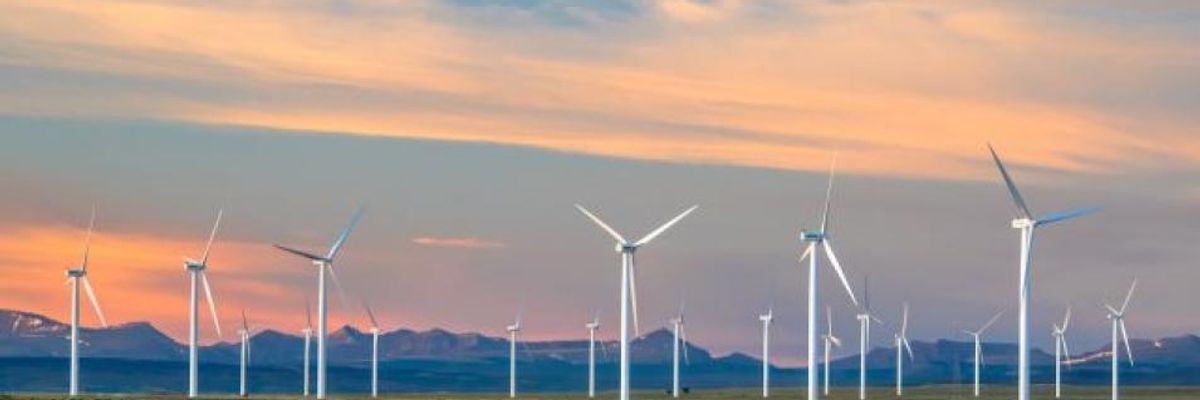
"Scotland also has plans for car parks that charge electric vehicles, having called for the end of gasoline-driven cars by 2032," Cole writes. (Photo: David Clarke/Flickr/cc)
75% of Scotland's Electricity Now Green; All Cars Electric by 2032
People who talk about our finding future solutions to the climate emergency are just out of date. The solutions exist, it is just a matter of implementing them, of political will.
Scotland added another 6% of green energy in 2018, so that nearly 75% of its annual gross electricity consumption came from renewables, chiefly wind, solar and hydro. Scotland's population is 5.4 million.
The increase in green energy came mainly from new offshore wind.
New offshore wind also allowed the UK to get 33% of its electricity from renewables in 2018. Although the UK is far behind Scotland in the green energy transition, it is nearly 12 times more populous, at 66 million, and so for it to get fully a third of its electricity from green sources is in real numbers a much bigger deal. British carbon emissions fell 3% last year.
Scotland and the UK have further big plans for new floating offshore wind turbines, a technology pioneered off the coast of Scotland by Shell.
Britain as a whole wants to get 30% of its electricity from wind alone by 2030.
Scotland is also doing groundbreaking research and development on wave and tidal energy, which has the advantage of being steady (unlike wind and solar). A small demonstration project is already powering 2600 homes in Scotland, and there are near-term pans to expand it.
People who talk about our finding future solutions to the climate emergency are just out of date. The solutions exist, it is just a matter of implementing them, of political will.
Scotland has that political will. (Truth in advertising, my maternal grandfather was a McIlwee, which I take it makes me an honorary Glaswegian).
Scotland also has plans for car parks that charge electric vehicles, having called for the end of gasoline-driven cars by 2032. The Scotsman says, "Revolutionary vehicle-to-grid (V2G) technology will also be employed at the hubs, allowing charged cars to feed electricity back to the smart grid where it can be used to power homes and businesses."
An Urgent Message From Our Co-Founder
Dear Common Dreams reader, The U.S. is on a fast track to authoritarianism like nothing I've ever seen. Meanwhile, corporate news outlets are utterly capitulating to Trump, twisting their coverage to avoid drawing his ire while lining up to stuff cash in his pockets. That's why I believe that Common Dreams is doing the best and most consequential reporting that we've ever done. Our small but mighty team is a progressive reporting powerhouse, covering the news every day that the corporate media never will. Our mission has always been simple: To inform. To inspire. And to ignite change for the common good. Now here's the key piece that I want all our readers to understand: None of this would be possible without your financial support. That's not just some fundraising cliche. It's the absolute and literal truth. We don't accept corporate advertising and never will. We don't have a paywall because we don't think people should be blocked from critical news based on their ability to pay. Everything we do is funded by the donations of readers like you. Will you donate now to help power the nonprofit, independent reporting of Common Dreams? Thank you for being a vital member of our community. Together, we can keep independent journalism alive when it’s needed most. - Craig Brown, Co-founder |
Scotland added another 6% of green energy in 2018, so that nearly 75% of its annual gross electricity consumption came from renewables, chiefly wind, solar and hydro. Scotland's population is 5.4 million.
The increase in green energy came mainly from new offshore wind.
New offshore wind also allowed the UK to get 33% of its electricity from renewables in 2018. Although the UK is far behind Scotland in the green energy transition, it is nearly 12 times more populous, at 66 million, and so for it to get fully a third of its electricity from green sources is in real numbers a much bigger deal. British carbon emissions fell 3% last year.
Scotland and the UK have further big plans for new floating offshore wind turbines, a technology pioneered off the coast of Scotland by Shell.
Britain as a whole wants to get 30% of its electricity from wind alone by 2030.
Scotland is also doing groundbreaking research and development on wave and tidal energy, which has the advantage of being steady (unlike wind and solar). A small demonstration project is already powering 2600 homes in Scotland, and there are near-term pans to expand it.
People who talk about our finding future solutions to the climate emergency are just out of date. The solutions exist, it is just a matter of implementing them, of political will.
Scotland has that political will. (Truth in advertising, my maternal grandfather was a McIlwee, which I take it makes me an honorary Glaswegian).
Scotland also has plans for car parks that charge electric vehicles, having called for the end of gasoline-driven cars by 2032. The Scotsman says, "Revolutionary vehicle-to-grid (V2G) technology will also be employed at the hubs, allowing charged cars to feed electricity back to the smart grid where it can be used to power homes and businesses."
Scotland added another 6% of green energy in 2018, so that nearly 75% of its annual gross electricity consumption came from renewables, chiefly wind, solar and hydro. Scotland's population is 5.4 million.
The increase in green energy came mainly from new offshore wind.
New offshore wind also allowed the UK to get 33% of its electricity from renewables in 2018. Although the UK is far behind Scotland in the green energy transition, it is nearly 12 times more populous, at 66 million, and so for it to get fully a third of its electricity from green sources is in real numbers a much bigger deal. British carbon emissions fell 3% last year.
Scotland and the UK have further big plans for new floating offshore wind turbines, a technology pioneered off the coast of Scotland by Shell.
Britain as a whole wants to get 30% of its electricity from wind alone by 2030.
Scotland is also doing groundbreaking research and development on wave and tidal energy, which has the advantage of being steady (unlike wind and solar). A small demonstration project is already powering 2600 homes in Scotland, and there are near-term pans to expand it.
People who talk about our finding future solutions to the climate emergency are just out of date. The solutions exist, it is just a matter of implementing them, of political will.
Scotland has that political will. (Truth in advertising, my maternal grandfather was a McIlwee, which I take it makes me an honorary Glaswegian).
Scotland also has plans for car parks that charge electric vehicles, having called for the end of gasoline-driven cars by 2032. The Scotsman says, "Revolutionary vehicle-to-grid (V2G) technology will also be employed at the hubs, allowing charged cars to feed electricity back to the smart grid where it can be used to power homes and businesses."

